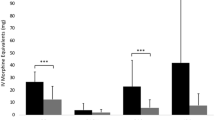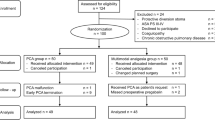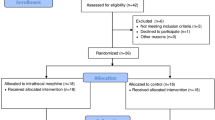Abstract
Though patient-controlled analgesia (PCA) has been in use for over a decade, it has been popularized only recently. Conventional techniques of intermittent intramuscular (IM) administration of analgesia have fallen short of meeting the needs of patients following major abdominal surgery. This has prompted a search for methods to improve postoperative pain management. Though PCA has been accepted in many hospitals, few studies comparing conventional IM administration of morphine with PCA have been performed. A prospective randomized study comparing IM- and PCA-administered morphine in 62 patients undergoing colon surgery was performed. A comparison of the efficacy of analgesia and extent of sedation using these approaches shows that PCA allows for analgesia with less sedation and less drug requirement than that of IM administration. No differences were noted in postoperative duration of ileus, duration of hospitalization, and total hospital costs. This study confirms the safety and efficacy of PCA, and should be considered the current optimal method of controlling pain following major colonic surgery.
Similar content being viewed by others
References
Bollish SJ, Collins CL, Kirking DM, Bartlett RH. Efficacy of patient-controlled versus conventional analgesia for postoperative pain. Clin Pharm 1985;4:48–52.
Keeri-Szanto M, Heaman S. Postoperative demand analgesia. Surg Gynecol Obstet 1972;134:647–51.
Graves DA, Foster TS, Batenhorst RL, Bennett RL, Baumann TJ. Patient controlled analgesia. Ann Intern Med 1983;99:360–6.
Miller RR. Chnical effects of parenteral narcotics in hospitalized medical patients. J Clin Pharmacol 1980;20:165–71.
Graves DA, Arrigo JM, Foster TS, Baumann TJ, Batenhorst RL. Relationship between plasma morphine concentrations and pharmacologic effects in postoperative patients using patient-controlled analgesia. Clin Pharm 1985;4:41–7.
Bennett RL, Griffen WO. Patient controlled analgesia. Contemp Surg 1983;22:75–89.
Bennett RL, Batenhorst RL, Birins BA, et al. Patient controlled analgesia: a new concept of postoperative pain relief. Ann Surg 1982;195:700–5.
Baumann TJ, Batenhorst RL, Graves DA, Foster TS, Bennett RL. Patient controlled analgesia in the terminally ill patient. Drug Intell Clin Pharm 1986;20:297–301.
Swerdlow M, Alexander M, Daw RH. A study of postoperative pain. Acta Anaesthesiol Scand (suppl) 1963;7:1–19.
Author information
Authors and Affiliations
Additional information
Read at the meeting of the American Society of Colon and Rectal Surgeons, Washington, D.C., April 5 to 10, 1987.
About this article
Cite this article
Albert, J.M., Talbott, T.M. Patient-controlled analgesiavs. Conventional intramuscular analgesia following colon surgery. Dis Colon Rectum 31, 83–86 (1988). https://doi.org/10.1007/BF02562633
Issue Date:
DOI: https://doi.org/10.1007/BF02562633




